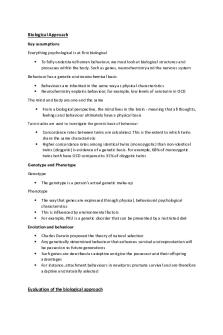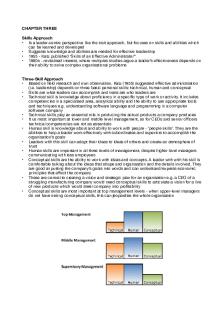Interactionist Approach PDF

| Title | Interactionist Approach |
|---|---|
| Course | Applied Psychology |
| Institution | Manchester Metropolitan University |
| Pages | 1 |
| File Size | 55.7 KB |
| File Type | |
| Total Downloads | 30 |
| Total Views | 140 |
Summary
Download Interactionist Approach PDF
Description
THE ECLECTIC/ INTERACTIONIST APPROACH Each approach is not enough for a full explanation It is difficult to capture a full understanding of human thought, feeling and behaviour in on perspective. An alternative way of expressing this is to say that attempts to explain all behaviour from a single perspective can result in an overly narrow view of human nature. The suggestion is therefore one that states psychologists should be open to the idea of combining ideas from different theories and methodologies into an eclectic approach, if they wish to have a complete understanding of human behaviour. The eclectic approach can take different forms: - THEORETICAL ECLECTICISM Combination of different theoretical ideas - METHODOLOGICAL ECLECTICISM Combination of different research methods - EPISTEMOLOGICAL ECLECTICISM Combination of different positions in the debates in psychology - APPLIED ELECTICISM The use of combinations of approaches in applied psychology e.g. combinations of therapies in treatments of atypical behaviour ADOPTING AN ECLECTIC APPROACH TRIMODAL THEORY Stevens proposed a model accounting for combining different approaches in psychology. According to the model there are three modes of understanding behaviour. The primary mode concentrates on the biological basis of behaviour e.g. biological approach The secondary mode focuses on symbolic processes (meaning) e.g. behaviourist, cognitive, social learning theory, psychodynamic approaches The tertiary mode focuses on reflexive awareness. E.g. humanist approach APPLICATIONS OF ECLECTIC APPROACH THE TRIMODAL MODEL OF GENDER THE DIATHESIS STRESS MODEL OF MENTAL ILLNESS Offers the most complete explanation of mental disorders such as schizophrenia and Primary mode focuses on the biological sex of the individual and hormones depression. Secondary mode focuses on meanings of the society and learning of appropriate it includes both biological and psychological/environmental aspects that must work gender behaviour Tertiary mode the individual has the choice whether or not to perform the gender together and interact to produce the disorder in people appropriate behaviour the DSM offers a complete explanation including both biological (nature) and environmental (nurture) aspects must work together (interact) to produce the disorder in people - Places too much emphasis on the tertiary mode and the humanistic approach + Modern psychiatrists/clinical psychologists value the eclectic approach and argue (allowing individuals to reflect on their behaviour & to change that it is the most effective way to improve the life of someone suffering from a - It is limited by the DIRECT CONTRADICTIONS between the modes psychotic disorder such as schizophrenia e.g. the biological approach argues for the biological determinism of behaviour and denies our ability to choose. this model is an attempt at eclecticism in practice TREATMENT OF SCHIZOPHRENIA/DEPRESSION If there was a successful treatment for schizophrenia base don one approach, we would not need to use any other therapies Clearly this is not the case e.g. with unipolar depression we would normally use both a biological approach and behaviourist cognitive strategies to treat mental disorders and reduce family/environmental stress This combined approach has been found to be more effective than using a single approach The drugs alleviate the symptoms while the cognitive therapy changes thought patterns to prevent the person getting depressed in the future EVALUATION OF ECLECTIC APPROACH + There are examples of OVERLAPS between the approaches and an eclectic approach is effective in recognising these e.g. behaviourists and SLT overlap + This approach takes the best part of all approaches and COMBINES them to give a BETTER UNDERSTANDING of behaviour e.g. behaviourists believe only observable behaviour should be studied and ignore processes, this leads to an incomplete explanation of how humans produce responses. the internal mental processes are a key part of being human + In therapy, the approach must appropriate to the particular problem is used because what matters most is helping the client and so eclecticism provides a MORE THERAPEUTIC TOOL + Human behaviour is TOO VARIED & COMPLEX to be explained by just one approach alone this approach provides a much FULLER EXPLANATION of human behaviour + Too much emphasis on one approach may mean that relevant information is missed from other approaches - There are IRRECONCILABLE DIFFERENCES some approaches are directly contradictory and CANNOT BE COMBINED e.g. biological and humanism - It is NOT CLEAR how the different approaches are COMBINED in practice some approaches work on the basis of very different methods which means that in practice, they are still likely to remain separate - Being eclectic may mean that there is NO THEORETICAL BASIS to psychology one of the key criteria of science is the importance of underlying theory when explaining behaviour. - Using many different approaches may lead therapists to become a jack of all trades and master of none. It is very difficult to know all the approaches equally well therefore eclecticism may actually be DISADVANTAGEOUS TO PATIENTS rather than beneficial. It is difficult to know when to combine approaches or use on approach in one situation and another in a another situation...
Similar Free PDFs

Interactionist Approach
- 1 Pages

Literal Approach
- 3 Pages

Literal Approach
- 2 Pages

Biological approach
- 2 Pages

Psychodynamic Approach
- 2 Pages

Reading Materials (Fuller Approach)
- 20 Pages

Lecture 2 - Skills Approach
- 3 Pages

The cognitive approach
- 1 Pages

A - LINGUISTIC APPROACH
- 2 Pages

AV Cardiac arrest approach
- 31 Pages

Dramatistic Approach notes
- 3 Pages

Capability approach riassunto
- 3 Pages
Popular Institutions
- Tinajero National High School - Annex
- Politeknik Caltex Riau
- Yokohama City University
- SGT University
- University of Al-Qadisiyah
- Divine Word College of Vigan
- Techniek College Rotterdam
- Universidade de Santiago
- Universiti Teknologi MARA Cawangan Johor Kampus Pasir Gudang
- Poltekkes Kemenkes Yogyakarta
- Baguio City National High School
- Colegio san marcos
- preparatoria uno
- Centro de Bachillerato Tecnológico Industrial y de Servicios No. 107
- Dalian Maritime University
- Quang Trung Secondary School
- Colegio Tecnológico en Informática
- Corporación Regional de Educación Superior
- Grupo CEDVA
- Dar Al Uloom University
- Centro de Estudios Preuniversitarios de la Universidad Nacional de Ingeniería
- 上智大学
- Aakash International School, Nuna Majara
- San Felipe Neri Catholic School
- Kang Chiao International School - New Taipei City
- Misamis Occidental National High School
- Institución Educativa Escuela Normal Juan Ladrilleros
- Kolehiyo ng Pantukan
- Batanes State College
- Instituto Continental
- Sekolah Menengah Kejuruan Kesehatan Kaltara (Tarakan)
- Colegio de La Inmaculada Concepcion - Cebu



